Table of Contents
Chapter 03
Sketching AND Drawing
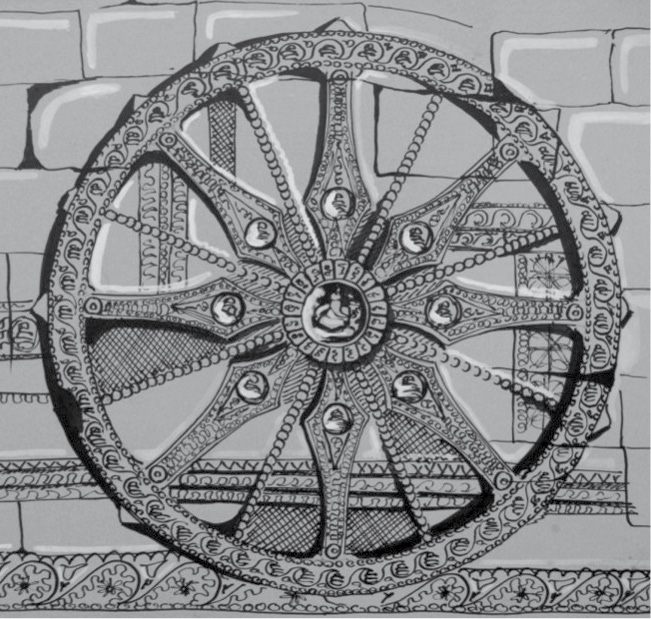
Irrespective of one’s drawing aptitude, we all know it is an amusing and a rewarding activity. Drawing, however you know is an essential discipline in certain professions as well. In all fields of visual arts like design, architecture, media and fine arts there is this common assumption that before making anything it is first ‘drawn’ or ‘planned, refined and perfected at drawing’ that is, before it is made. It is true that all great minds in visual fields made drawing and have left behind the traces of their design process in the form of drawings. So what is drawing to these professions?
Drawing is a system of representing visual ideas and thoughts on a surface. Most commonly it is used as a means of depiciting three dimensional reality on a two dimensional surface using pencil, charcoal, crayon, pen, brush etc on a paper, cloth, wall etc. Drawing is also used as a tool for ‘visualisation’. In other words, visualisation means representation of one’s imagination for others. Where design ideas can be two dimensional or three dimensional. Drawing, in spite of being a two dimensional representation, can provide a convincing illusion of three dimensional environments.
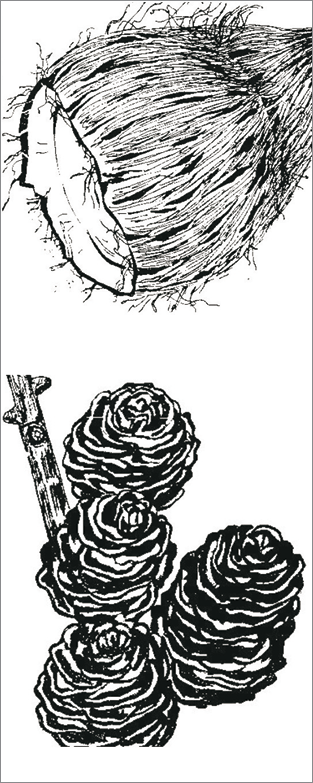
Sketching from natural objects
You know its fun to draw!
In visual communication drawing is regarded as the most economical and efficient way to record, illustrate and express thoughts and ideas, where as even elaborate verbal explanations remain inadequate to do so. In graphic design images are intentionally arranged along the text so to put across complex information or a thought which the viewer receives as a meaning arising by connecting two. Words and images put together makes communication simpler, complete and effective. In present times photography has become alternative way of generating images in graphic compositions but drawing is still preferred in visualisation and considered ideal. Further, we will see some such virtues of drawing that being of practical use in the graphic profession and importantly, in sensitising our perception of a visual form and sensitising perception to become a sensitive and perceptive individual.
Other than its usefulness in design, from ancient times drawing is respected as an art form. Like poetry, music, dance, acting, storytelling etc., drawings also influence our emotions since it can extract and represent those subtle, seen and unseen gestures, expressions, through characteristic fluency and affective quality of line. Since kind of drawing is a form of personal expression it is indeed subjective and hence relative to the viewer’s participation too. Participation here means that in our imagination we are expected to participate in the process of its making while appreciating the work of drawing. In fine arts such subjectivity is appreciated as one’s unique style that is appropriate with the chosen subject and intent.
Drawing is a skill which is perfected by its keen interest in its enticing activity of observation and by patient and persistent practice of representing it. Therefore, observation is a primary and essential requisite in learning drawing to appreciate visual aspects and attributes of things and by doing so it proves as a thoughtful beginning in understanding visual world and visual language and importantly its grammar. There are different ways to draw, such as drawing from seeing, drawing from memory, drawing by analysis and drawing from imagination etc. In professional practice all kinds of drawings are used by a graphic design. Let’s first understand and acknowledge some of the virtues and benefits of practicing drawing.
Activity 1
Draw two objects from your observation, one each from nature and man-made which are similar in shape and texture.
Types of Drawing
To ‘draw’ means to ‘fetch’ or ‘pull’ as we pull water from the well. In the fields of design, fine arts and architecture, to draw’ means to fetch ideas from ‘within’ that is mind. These ideas are our thoughts, emotions, feeling etc. Similarly, we fetch ideas from external reality i.e. man-made environment, social environment and natural environment. Drawing also means to describe to extract and to capture the essence of internal and external reality and represent it in a best possible way using appropriate medium.
Sketch means first rough draft or plan of any design, an outline or a drawing using pen, pencil or any other similar medium. It also means a descriptive representation of a concept, thought or principal ideas. In the fields of art, design and architecture the word sketching and drawing are used as synonyms although there is a subtle difference in the meanings of there words.
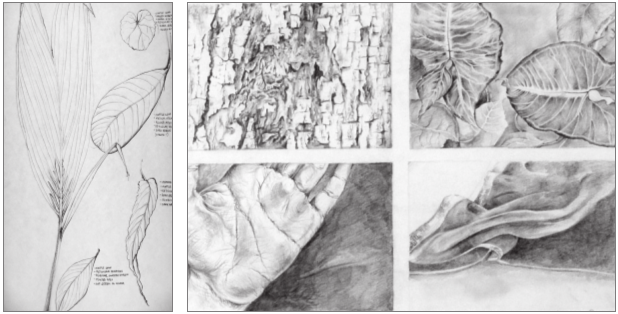
Broadly, there are two categories of drawing—drawing from external reality that includes drawing objects and artifacts from man-made and socio-cultural environment. It includes drawing trees, mountain, animals and all entities from the natural environment. Drawing human figures and portraits of individuals needs advanced drawing skills. Traditionally these three activities are termed as object drawing, nature drawing and human figure drawings.
Drawing from internal reality includes drawing from me
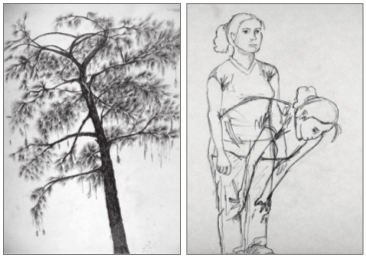
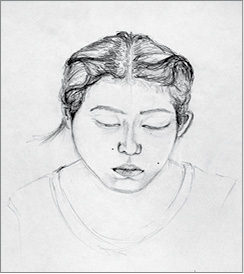
Proportion, features, gestures and expressions in natural forms.
mories. It could be a past event activity. The other type is to draw from imagination. Many verbal or non-verbal ideas keep coming to our mind. Sometimes such ideas are highly creative in quality and we can see them very vividly before our mind’s eye. You can always capture such ideas and represent them on paper as visual metaphors.
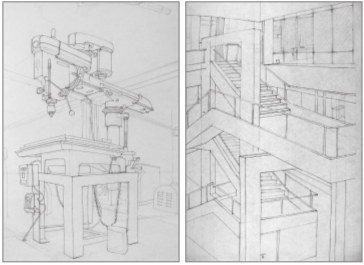
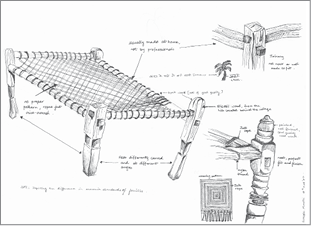
Perception of hidden structural relationship of parts and representation of depth in man-made environment
Sometimes we have information about objects and things around us. Based on that information we can go on constructing and visualising many more ideas. When we put them on paper they come in the form of representation drawings, perspective contraction drawings for 2D and 3D objects which are collectively called design drawings. Design drawing also many times have high creative value. Apart from the above we also want to draw our thoughts, emotion and feelings in a more subtle and abstract way. Such drawings are called ‘expressive drawings’.
Whether it is drawing from external reality or from internal reality, observational skills are absolutely necessary for drawing. In the first case you observe objects, nature, humans and life. In the second case you observe from within yourself. It is more contemplative, meditative and self analysing.
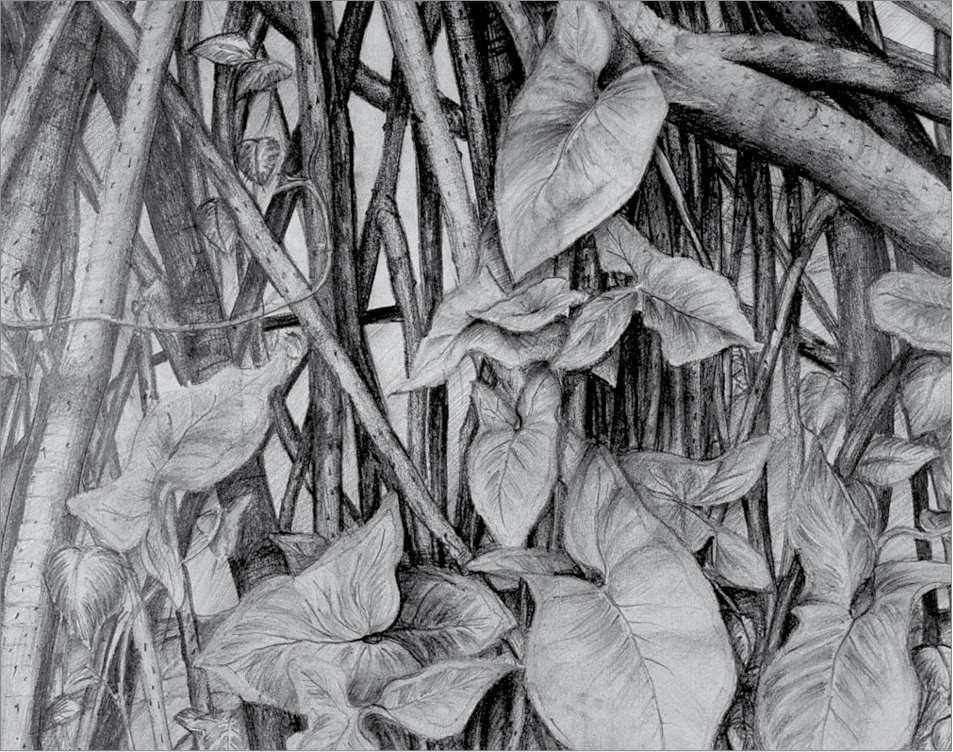
Discovering differences and similarities of visual features in natural objects
All the above-mentioned types of drawing are discussed in details in following paragraphs.
Drawing is a representation and it is always based on some references and information. References for drawing can be from one’s memory, from on the site observations, based on technical and dimensional information, or based on one’s pure imagination and fantasy. Very broadly we can classify types of drawings which are based on such fundamental sources of references or information.
Activity 2
In your sketch book do studies of plants and its sections of plants and leaves. Make one final composition in ¼ imperial sheet in water colours.
Drawing from Memory
Drawings done referring to visual memory are memory drawings. It is a most practiced kind of drawing since a vivid visual memory persuades one to draw; many people opt to draw this way. We are often asked to make drawing representing events and experiences like independence day celebration, kite festival, farmers harvesting, visit to zoo etc are subjects drawn as memory drawings.
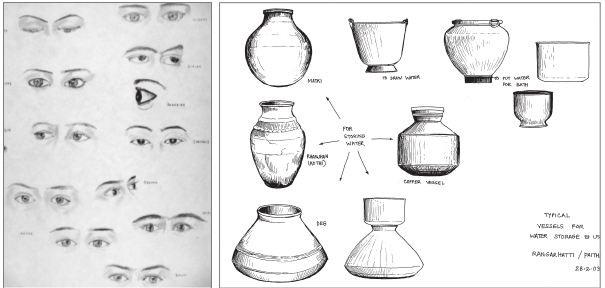
These are based on one’s experiences of events and environments and therefore considered free from any imaginary inclusions. It is said that designer’s quality of visualisation is apparent through his drawings. And visualisation drawings are entirely based on the volume of one’s visual memory and ability to draw from it. Animation films,
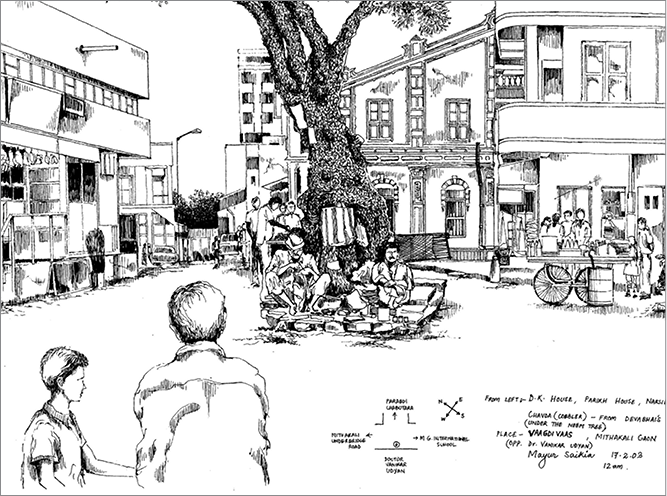
Drawing asks for a sustained and distraction-free attention on a subject
graphic illustrations, space and product visualisations etc are its major application fields. However, as said earlier, it is regarded that observational drawing is a formal beginning to develop visual memory and also the skills in any type of drawing, one need carefully seeing and analysing visual world so to enrich the stock of visual information and its memory.
Activity 3
Take the reference of anatomy books and make 30 sketches of different parts of body, positions of head and complete human figures.
Drawing from Observation
Often one starts with memory drawing but soon realises that to make a good drawing one needs to improve analytical observation and have a clearer idea of structure and visible form to be drawn as an image.
Drawing helps in building visual memory
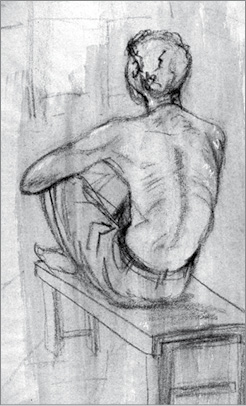
Fluency of lines help
develop unity, continuity and rhythm
Drawing helps develop empathy for others
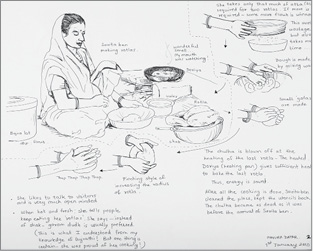
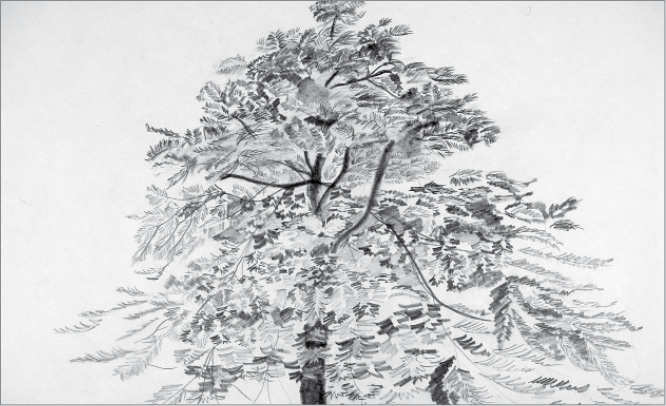
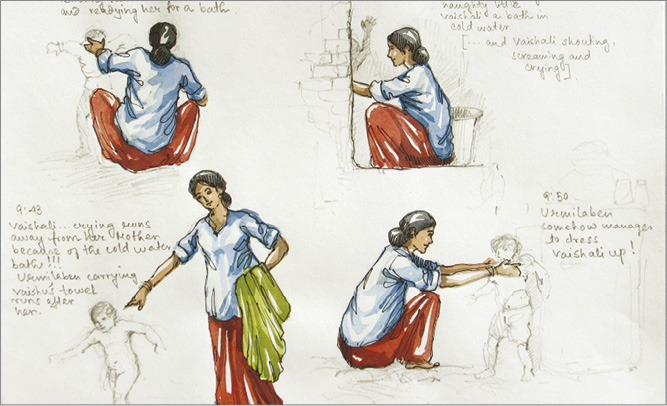

Hence in all visual arts and design schools emphasis is given to observational drawings. It can be explained as a method of seeing and drawing on the site and from a fixed view point. It is also called drawing from actual or real where there is no scope for any modification by one’s memory or imagination. It is regarded as an attempt to study and appreciate the structure of a thing and represent the form as it is.
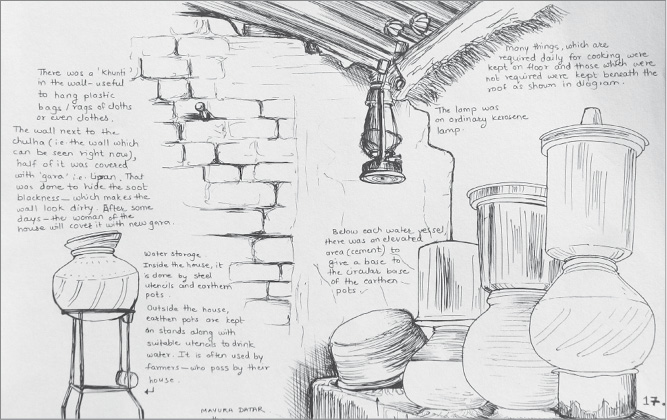
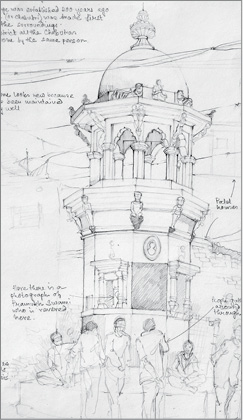
Nature and complexity of context shapes a form
Practice in observational drawing helps improve sense of curiosity and visual analysis of the forms and spaces thus strengthening cohesion of larger structures and interrelationship among its parts. These type of drawings have application in the works of illustrations of informative and scientific nature where accuracy and clarity of information is crucial.
Drawing from Dimensional Information
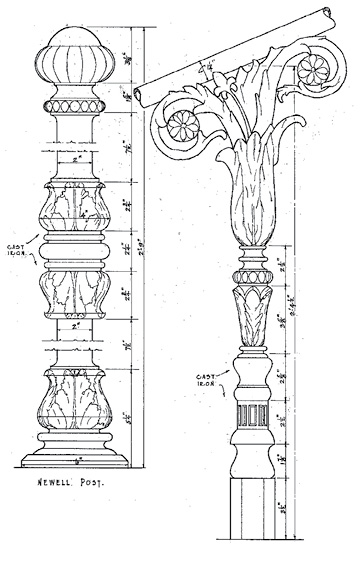
This type of drawing is of technical nature. It is also called production drawing which is crucial in manufacturing processes since it presents dimensional information of structures to be made. Precision and accuracy is of importance and any error in visualisation and representation can lead to mistakes at the production stage. There are variety of dimensional drawings used according the purpose and conventional practices. All engineering drawings which are also known by their field of applications fall under this category such as architectural drawing, mechanical drawing, land survey drawing etc. These drawings mainly include projection of views and mostly in the order of a cube. Orthographic, isometric and sectional projections, technical perspective and contour drawings are few technical names of such drawing types. In industrial design schools formal mechanical drawing is made easy and free of any instruments. It is done with the help of supporting isometric and orthographic grids underneath of translucent paper on which objects are drawn over an order of the grid. It is useful for technical visualisations and representations of small scale products and commonly known as analytical drawing.
Drawing from Imagination
Visual metaphors showing juxtaposition of two forms. For an effective juxtaposition it is important to have good compatibility of visual properties of chosen elements. Drawing helps to see deeper attributes of the things. Discover the meaning resulting from combination of attributes of ‘Watermelon and Pot,’ ‘Rose and Note,’ ‘Anvil and Man’. Often a conceptual image or a ‘symbol’ is a juxtaposed image.
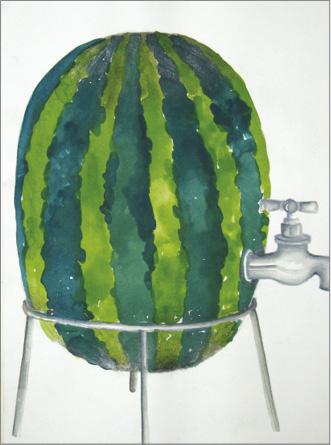
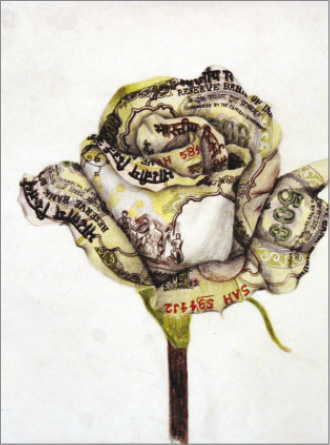
Visual artists are deeply engaged in the process of visual imagination. They are occupied by thinking and imagining about their solutions to the material problems and hence occupied in making a world from their creativity and fantasy. They are engaged in adding value to the function of a product, providing appealing visual experiences and conveying meaningful messages by their design for the mankind. They have to create such since it doesn’t exist. All drawings that incorporate imaginary and non-existing things are imagination drawing. Painters, graphic artists, sculptors, illustrators, animation artists, product and space designers all at the ideation stage are busy in doing such drawings.
Expressive Drawing
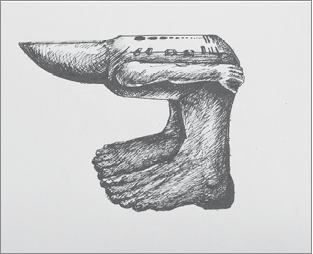
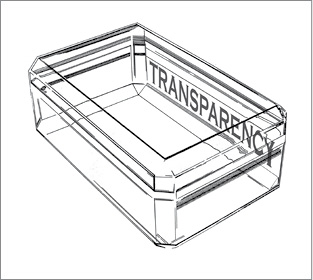
Drawing primarily is an analytical activity. Being expressive it is an emotive medium too. It is an intense yet a playful coordination of visual perception, visual analysis and interpretation, drawing medium and intended subject or message. Since it is done with hands, it is a skill. For a visual artist challenge is to show optimum likeness of the subject in the form of drawing. Representations could be of variety of kinds from informative and realistic to conceptual and abstract. Depending on the intensions visual artist selects from the range of mediums to make a drawing more effective since various drawing mediums produce a characteristic effect of its own. A ratio of thickness of stroke to paper is required to be understood. To show meticulous details on a small sheet visual artist may prefer mediums leaving a thin and sharp mark such as pencil and pen. To represent the same image on a larger surface one may prefer thicker strokes so that it can be perceived from distance. Incidentally thicker mediums are also soft on paper. Softer mediums like charcoal and bold led pencils effectively respond to pressure, direction and pace of hand movement. Thicker strokes with subtle variations in tone and thickness help in showing character and expressiveness along edges and mass of the subject. Such bold mediums are preferred in rapid gesture drawings where representation of form happens by the mass of the subject instead of its edges.
Virtues of a Good Drawing
While drawing a simple shape; say a leaf, we go close, touch, observe and feel its visual, tactile properties, move around and select a representative view to draw it. This way we begin appreciating simple shapes by its specific nature, condition and situation. In the process we see and delineate a shape by its edges and also interpret it by its distinctness from the rest. It is an enquiry about a typical gesture made and associations prompted by that gesture in that shape. Thus, a thoughtful drawing is an attempt in articulations of uniqueness of a shape which help us enrich our perception, classification and vocabulary of shapes.
Drawing trains the eye to see, understand and discover distinctness of a shape from its surrounding
System of Structures
Everything has a structure. Structures are hidden and they hold parts together. In the process of drawing we curiously examine the system of a given structure in term of relative proportions, strength, joinery, and activity sustained along its junctions, extensions and at tips. It helps notice, analyse and trace symmetrical or asymmetrical nature of balance, patterns and a possible geometrical layout within and along the edges of a structure. Since drawing has to complete a form it helps in understanding interrelations and interdependency among the parts in a from. In case of drawing of natural structures it is an attempt to understand that inspiring simplicity, minimalism, and efficiency of a system at micro as well as macro level.
Drawing trains the eye to see, understand and discover complexities of structures in natural and man-made environment
Embedded Similarity and Difference
Drawing trains the eye to see, understand and discover differences and similarities in things
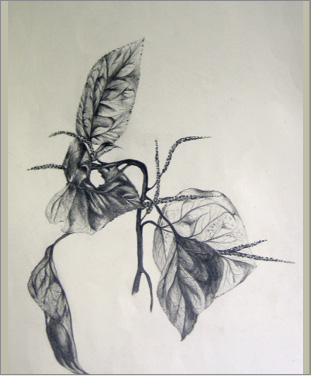
Drawing compels a careful reading, leading to a subtle classification of shapes and forms. By doing so it strengthens the ability to relate and group things from a given environment. In an environment, patterns recur with fine variations. A careful observation leads to perceiving the nuances and changing effects in the visual gestures and expressions among the elements. Say in a drawing of a plant with number of leaves similar but variedly sized, toned, lit, shaded, placed, oriented, and overlapped in a natural way sensitises one’s perception for the embedded similarities and differences among the parts in a system. Interestingly, it also makes one notice and edit the superfluous, displaced and irrelevant elements from otherwise a composite environment. It is a decisive ability in design that a good designer settles on anything not less than a perfectly fitting option to the context from a variety of created choices.
Appealing Complexity
Drawing expects perception of an object that is more than that of usual and effortless recognition of it. It is all right for an onlooker to have a glance or a look at things in a speed as if seen through a fast moving window. However, for a designer and especially a visual communicator, visual environment is full of appealing complexities due to the reasons, interrelations and meanings of things in it. Drawing asks for a sustained and distraction-free attention on a subject. You know, it takes a lot to complete a good drawing. It evolves along several cerebral considerations such as sense of unity and relative proportion, comprehension of hidden structure and retention of balance in it, rhythm and consistency in the quality of line, depiction of property of material, its surfaces and details over it. Therefore, drawing helps one to pay attention and appreciate the visual qualities of things so as to comprehend and represent them correctly.
Drawing helps fine tune eyes and hands for the rhythm in line, shape, form and a structure
Drawing enhances perceptual concentration
Unity of Visual Vocabulary
Drawing is a human enterprise. When we draw we process, simplify and translate the reality into the drawing’s typical language. This translation gives birth to a distinctive vocabulary of lines and strokes, by their curvilinear, angular and characteristic behaviour, fluctuations in thinness, thickness, value, and importantly by extracted feel and invisible attributes of the subject represented in it. This all paves a way to build unity, continuity and rhythm in the lines, strokes and eventually in a resulting integrated form and effect. Often, so called styling in three dimensional design and simplification of graphical forms are inspired by the embedded quality of drawings done at an exploratory stage.
Empathy and Visual Articulation
A routine practice in observational drawing helps develop a vivid visual articulation of forms. A form well perceived and drawn is stored permanently in the memory. It is present there and always accessible for further modification according to the context. It is therefore so fundamental that one regularly keeps sketching and drawing since there are plenty of things and situations out there and one won’t know what things may require in future compositions.
Since drawing is a reproduction or simulation of gestures, expressions, and personality of the subject, it asks for an empathetic enquiry and association with it. It is said that while drawing one lives in the state of the subject to do justice to the representation of the subject. Empathy takes one closer to insights and intuitions about an exclusive approach suitable to represent the subject. It is a demanding process and if achieved stands as an evidence of sincerity and integrity of the draftsman with the process and his subject.
Organic Unity
Every form has a context and it relates with it by its function and appearance. Nature and complexity of context shapes a particular form. Hence in design an elaborate enquiry of the context is a crucial part of the design process. Observational drawing extends one’s enquiry beyond a form into its purpose and environment. Even if form is isolated, enquiry extends into its likely counterparts and spaces thus, guiding one to perceive fitness in the relationship of a form with its original context. This exercise develops a healthy habit for a designer as a future form-maker to extend her/his attention to forms possible and expected environments or to actual design process, to come up with a fitting form for a given context.
Drawing helps understand the relation between the form and it’s context
Drawing helps form associations, perceive deeper experiences and meanings in things
Visual Meaning
Use the musical instruments available in your school and arrange them for still life study. Do at least 3 line studies, evaluate each shortly and choose the best composition for final work on ¼ imperial sheet in water colours.
Activity 4
Beyond the function of an object, a visual communicator looks at it as a ‘sign’ that is representing something more. To associate things from different domains based on some resembling features is a beginning of relating and connecting seemingly unrelated things for a greater experience or meaning. During drawing, a sensitive observer is always reading, registering and extracting such relations which can be useful. Though a symbol is a conceptual image, for an effective visual representation it is important to refer to compatibility of visual properties and features of chosen elements over mere conceptual attributes. Conceptual and visually incompetent forms may make the representation look literal and weak. Practice of good visual rhetoric is entirely based on the foundations of a refined form perception, lateral interpretations and incorporation of suitable visual features and attributes in one form.
Activity 5
Students will examine how to create a 3D effect on a flat surface and learn to draw in one-point perspective.
1. What is the role of drawing in different professions such as Graphic Design, Interior Design, Architecture, Fashion Design etc?
2. Do you think that practice of drawing helps in developing observational skills? Give reasons for your answer.
3. How does the choice of expressive drawing help in getting desired effect in the artwork. Explain with the help of suitable examples.